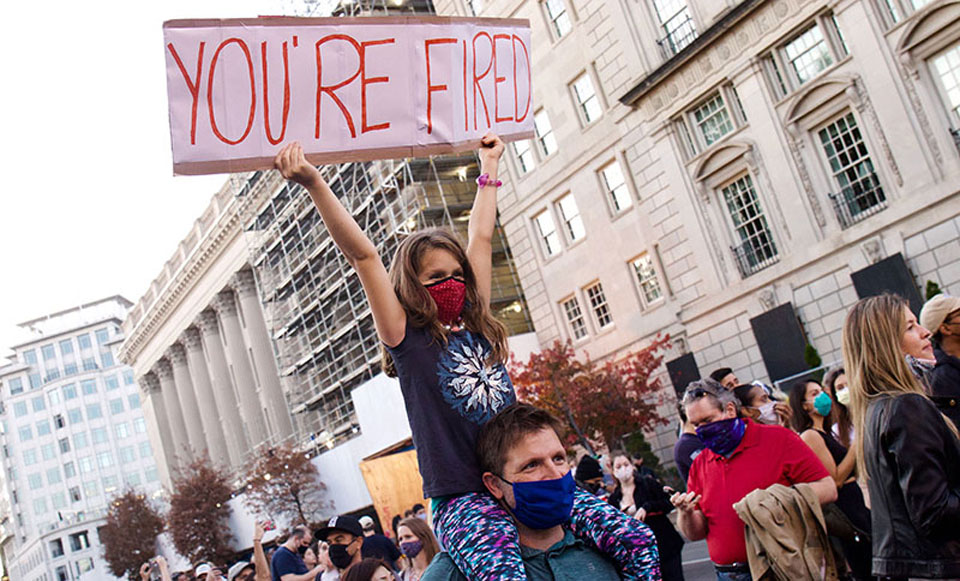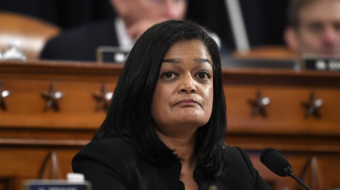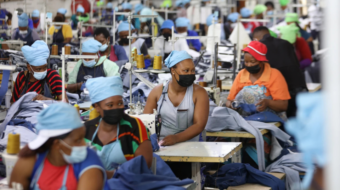
Third in a series exploring challenges facing the democratic labor-people’s coalition that was instrumental in ousting Trump. Parts one and two appeared previously in People’s World.
Trump’s appeal to white racial identity and toxic masculinity was the most significant factor in mobilizing his 74 million voters. Trump and his minions deployed racism in a failed attempt to overturn the election by demanding the trashing of millions of African American votes, claiming they were fraudulent.
Trump is leaving behind massive wreckage, damage to democratic institutions, and deep and volatile racial and social divisions. But Trumpism, based on white supremacy, misogyny, xenophobia, homophobia, anti-Semitism, Islamophobia, lies, conspiracy theories, and mass disinformation, the stuff of fascism, will continue as a potent movement.
The broad multi-racial labor-people’s democratic alliance, which acts both independently and works through and in alliance with the Democratic Party, was instrumental in electing Joe Biden and Kamala Harris. Many of these groups are now pressing the new administration with a people’s agenda on various issues.
This diverse alliance, including the new administration, makes up what Marxists refer to as a “popular front” or “all-people’s coalition.” Popular fronts gather together class, social, and democratic forces around a common goal – in this case, breaking the extreme-right domination of government – that can move the entire struggle forward once achieved.
The relative balance of class, social, and political forces also determines what is possible to achieve at a given time. Factors include divisions in the ruling circles, the strength of right-wing obstruction and its base of support, and the level of consciousness and unity of the multi-racial working class and its allies.
Anti-racism and anti-sexism are critical elements of class consciousness. The intoxication of significant numbers of white workers with racism and other potent right-wing ideologies undermines building united multi-racial majorities necessary to win short-term emergency economic and Covid-19 relief against GOP obstruction.
It also holds back the development of class consciousness and the multi-racial working class as a whole from fulfilling its mission to lead the struggle for a radical economic and political multi-racial democracy, or socialism.
More than economics
Building a sustainable united multi-racial majority cannot be reduced to economic or kitchen table issues. It is about so much more – it’s about intersecting economic, environmental, and social issues with racial and gender justice and dismantling systemic inequality embedded in every area of life. And it’s about creating a new narrative of a shared future and inclusive American and global identity.
“To come out of this (Covid-19) crisis better, we have to recover the knowledge that as a people we have a shared destination,” says Pope Francis. “The pandemic has reminded us that no one is saved alone. What ties us to one another is what we commonly call solidarity. Solidarity is more than acts of generosity, important as they are; it is the call to embrace the reality that we are bound by bonds of reciprocity. On this solid foundation, we can build a better, different, human future.”
Critical components of this new (shared American and human) identity should include “staples like pride in the country and pride in hard work, whether in the trades, at home, in government service or in the private sector,” says Ian Haney Lopez, director of the Racial Politics Project, in a framing paper that emerged from discussions in the AFL-CIO’s Commission on Racial and Economic Justice.
“But most importantly, an inclusive identity should be built around belonging, mutual respect, and mutual care,” says Lopez. (It means) belonging, the grounded sense that we all are members of this society in equal standing; mutual respect, seeing the basic humanity and dignity of others, even when we’re different; and mutual care, the pride, and security that comes from taking care of each other, offering help when we can and accepting help when we need it, confident we’ll be able to return the favor soon.”
And there are many issues upon which our diverse working-class and people find common ground while also addressing systemic inequality. Hospitals are being overwhelmed with Covid-19 patients, which is hitting communities of color the hardest. And we face an economic catastrophe, with communities of color experiencing depression level joblessness.
A survey by the African American Research Collaborative shows majority support across racial constituencies for ending family separation at the border (85% overall, 90% African American, 87% Latinx, 78% white); creating a path to citizenship for undocumented residents (87% overall, 90% African American, 90% Latinx, 81% white); making voting more accessible (97% African American, 87% white); access to affordable healthcare (94% African American, 85% white); decarceration (African American 85%, white 67%).
Less agreement exists around issues Trump and the GOP exploited to inflame racial divisions, for example: cut funding to police and redirect those monies to violence prevention programs (African American 70%, white 41%); or whether discrimination increased during the Trump years (61% overall, 76% African American, 47% white). In part, these responses reflect high levels of racial segregation – Black, Latino, and other people of color have a different lived experience than whites.
As Rev. Martin Luther King, Jr. said, “We must give ourselves to the struggle for wholeness until the end. Either we go up together or we go down together” against the three evils that divide and “otherize” people – racism, poverty, and militarism.
Building movements and infrastructure
U.S. history is rich with examples of economic and social gains won by “going up together.” Experiences profoundly transform people and society at large, including the fight to oust Trump. In fact, “moral fusion movements,” like the one led by Rev. William Barber III, are being built to rediscover common humanity and transform the nation’s entire political landscape.
Racism, sexism, homophobia, anti-Semitism, and Islamophobia are everywhere, and no one is immune to their influences. Recognizing these toxins and overcome them while integrating racial and gender justice into every issue is a continuous struggle.
It means building and rebuilding multi-racial, democratic, and progressive religious coalitions and movements, alliances, and information systems which counter the massive right-wing disinformation ecosystem – in short, infrastructure – in states and regions where the power of the GOP and right-wing is dominant.
Working Families executive director Matt Morrison argues Democrats disinvested in many congressional districts because extreme gerrymandering made them uncompetitive. The GOP and Trump filled the vacuum. But plenty of evidence exists to suggest that by investing in, organizing, engaging, and informing these voters, political change can occur.
Various activists pose winning strategies as a choice between mobilizing base voters of color, women, and youth or winning support among white working-class voters. In reality, both are necessary, along with persuasion, to achieve maximum voter turnout.
Most Trump voters came from suburbs and urban areas, while 20% came from rural areas. Still, many of these voters reside in battleground states or districts, where the GOP and extreme-right have invested and built infrastructure resulting in GOP elected officials. The broad multi-racial labor people’s democratic coalition in an organic alliance with the Democratic party will need to build infrastructure in these states and districts to defeat GOP bastions of power.
Unions are the largest organizations that bring Black, Brown, and white workers together in the struggle to overcome racist stereotypes. Organized labor is the fulcrum for building the broad multi-racial working-class and people’s democratic alliances while educating their members in a progressive political outlook.
The U.S. labor movement is experiencing a resurgence and expanding its relationships with various movements and constituencies, including Black Lives Matter. The multi-racial organized labor movement was a critical force in electing Biden and Harris, especially in battleground states, and has a significant presence in the presidential transition process. Meanwhile, Biden has promised to be the “most pro-labor president,” and labor expects the administration to make it easier to organize, including through appointments and executive actions.
The resurgence augers well for rebuilding the power and influence of the trade union movement. Deindustrialization heavily impacted organized labor across the “Rust Belt.” Once the steel mills and auto assembly plants closed, workers lost much of their connection through their unions to each other and progressive politics. Other organizations and entities like Fox News, the NRA, or right-wing Evangelical churches often filled that void.
In Wisconsin, when the GOP and Scott Walker won unitary power in 2010, the first thing they did was smash public workers’ collective bargaining rights followed by a right-to-work law in 2015. The GOP knew AFSCME and teachers’ unions were the backbone of the Democratic Party, and the new laws severely weakened it.
Simultaneously, the GOP imposed extreme gerrymandering and passed voter suppression laws restricting voting for African Americans, Latinos, and youth, including 33 bills in Walker’s first term. The GOP’s actions confirmed Dr. King’s warning, “The labor-hater and labor-baiter is virtually always a twin-headed creature spewing anti-Negro epithets from one mouth and anti-labor propaganda from the other mouth.”
The Democratic Party paid a stiff price when they divested in entire regions, rural areas, small towns, and suburbs, resulting in weakened infrastructure and alliances, allowing the right-wing to fill the vacuum. Growing labor and other democratic movements in alliance with the Democratic Party, or a “popular front,” will need to rebuild engagement, partnerships, and infrastructure in these places and many urban areas.
As Working Family’s Morrison points out, once organizations invest in infrastructure, a rapid political shift can occur. Developments like these are happening to one extent or another in Georgia, North Carolina, Arizona, Nevada, Texas, where changing demographics impact developments, and Wisconsin. These demographic changes, grassroots engagement, rebuilt movements, and alliances have a significant impact on the composition and character of the Democratic Party in return.
Ben Wikler, the Wisconsin Democratic Party’s chair, publicly acknowledged the debt owed to Stacey Abrams and Fair Fight in winning the state for Biden and Harris. Wisconsin Democrats implemented Abram’s blueprint for turning Georgia blue. The plan includes year-round mobilizing, massive voter registration, building across the state and at the grassroots, building alliances with diverse racial communities, organized labor, and other democratic movements, and turning to digital organizing during the pandemic.
Additionally, it means engaging in the “battle of ideas,” especially countering the massive disinformation and propaganda inundating people around the clock. Building the independent, progressive, and democratic media, including People’s World, is imperative, to tell the truth, expose new forms of racism and sexism, and tell working people’s stories.
In short, the U.S. multi-racial working class and people are in for a challenging and long-term fight for a multi-racial economic and political democracy based on racial and gender equality and sustainability. Though a daunting task, we build with collective purpose from what has already been collectively achieved in the struggle, beginning with the historic 2020 election victory.










